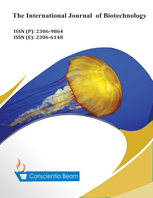Combined Antibacterial Activity of Honey Bees (Apis Florae) and Embelia Schimperi Extracts Against Standard and Clinical Isolated Bacteria
DOI:
https://doi.org/10.18488/journal.57.2019.81.75.83Abstract
Despite tremendous progress in drug development and treatment, infectious diseases caused by bacteria are still a major threat to human and animal health mainly due to drug resistances. These the ever-increasing threats demand a global effort to search for novel solutions. Different parts of plants and bee’s honey have been used, separately or in combination, as a source of therapeutic agents in traditional medicine since ancient time due to bioactive compounds they contain. Therefore the objective of this study is to determine the antibacterial activity of crude extract of Embelia schimperi leaves and combined with bee’s honey (Apis florae) against some standard and clinical pathogenic bacteria. The In-vitro antibacterial activity of the extracts was tested at different concentrations by using agar well diffusion method and measuring zone of inhibition. The data was analyzed by ANOVA. Both the clinical and standard bacteria showed sensitivity to E. schimperi with inhibition zones ranging from 7.17 ± 0.29 to 28.96 ± 0.25. The ethanol extract of E. schimperi leaves and ethanol extract blended with honey have showed significant inhibition against the tested organisms than the chloroform extract and chloroform extract blended with honey respectively. The inhibition zone was lower against S. aureus during both the Chloroform leave extract and the chloroform blended with honey. The highest inhibition zone was observed against E. coli with the ethanol leave extract and against K. pneumonia with the ethanol mixed with honey. Therefore, the E. schimperi leaves extract and synergy with honey has witnessed broad spectrum antibacterial activity.

